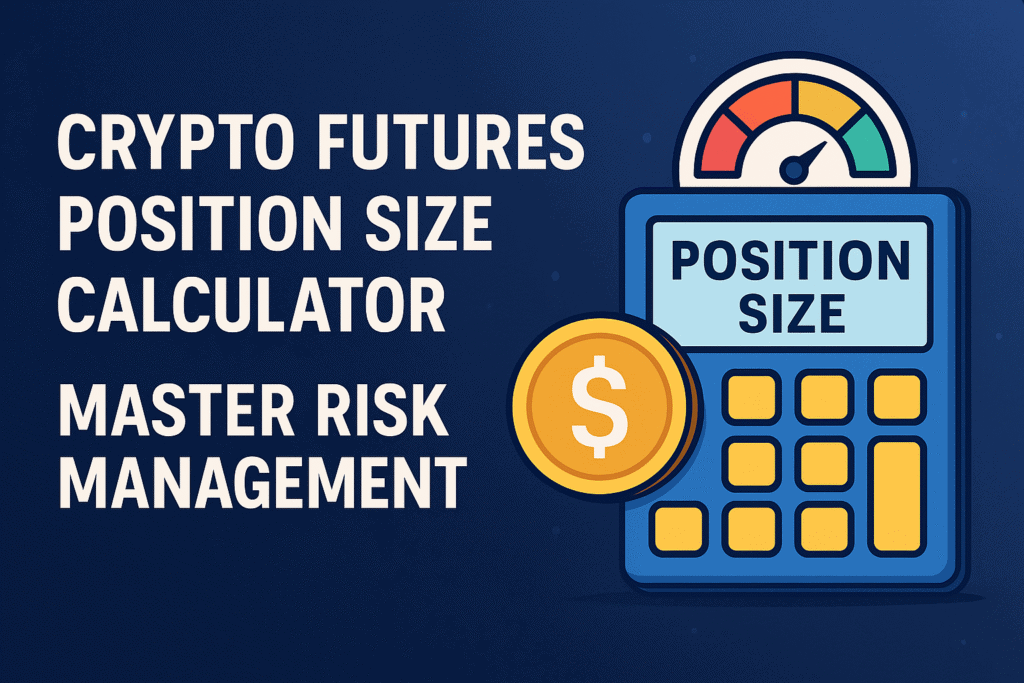
Professional crypto traders lose an average of 23% more capital than necessary due to improper position sizing, according to recent analysis of over 50,000 trading accounts. The difference between profitable and unprofitable futures trading often comes down to one critical skill: calculating the optimal position size for each trade based on account size, risk tolerance, and market conditions.
Position sizing represents the mathematical foundation of successful risk management, yet 78% of retail crypto futures traders admit to “winging it” when determining trade sizes. This approach inevitably leads to account destruction during volatile periods, regardless of trading skill or market analysis accuracy. The solution lies in systematic position size calculation that removes emotion and guesswork from risk management decisions.
Smart traders use precise position sizing calculators to maintain consistent risk exposure across all trades. Bitunix provides intuitive position sizing tools integrated directly into their trading interface, helping both new and experienced traders optimize their risk management approach. This comprehensive guide will teach you to calculate optimal position sizes manually and systematically, protecting your capital while maximizing profit potential.
Understanding Position Size Fundamentals
Position size refers to the dollar amount or number of contracts allocated to a specific trade relative to your total account balance. Proper position sizing ensures that no single trade can catastrophically damage your account, while still allowing sufficient exposure to generate meaningful profits.
The core principle involves risking a predetermined percentage of your account on each trade, typically between 1-3% for conservative approaches or 3-5% for more aggressive strategies. This percentage remains constant regardless of market conditions, trade setup quality, or recent performance, creating consistent risk exposure across all trading activity.
Position sizing differs fundamentally from leverage selection, though the two concepts work together. While leverage determines how much capital you can control, position size determines how much of your account you’re willing to lose if the trade fails completely.
Essential Position Sizing Variables
Account Balance and Risk Percentage
Your total account balance forms the foundation for all position size calculations. This includes available margin, unrealized profits from open positions, and any pending orders that might affect available capital. Accurate account balance assessment ensures position sizes remain appropriate as account equity fluctuates.
Risk percentage represents the maximum amount you’re willing to lose on any single trade. Professional traders typically risk 1-2% per trade, while more aggressive approaches might risk up to 5%. This percentage should reflect your trading experience, market conditions, and overall risk tolerance.
Stop Loss Distance and Entry Points
Stop loss distance measures the difference between your entry price and exit price if the trade moves against you. This distance, combined with your risk percentage, determines the maximum position size for any given trade setup.
Entry point precision affects position sizing calculations since small changes in entry price can significantly impact stop loss distances. Advanced traders often use multiple entry points or scaling techniques to optimize their average entry price and reduce stop loss distances.
Leverage and Margin Requirements
Leverage multiplies your buying power but also amplifies both profits and losses proportionally. Understanding how leverage affects position sizing prevents overexposure and ensures adequate margin maintenance throughout trade duration.
Different exchanges offer varying leverage options and margin requirements. Advanced traders often prefer Blofin’s flexible leverage options and sophisticated margin calculation tools for precise position size optimization. Margin calls occur when positions exceed available balance, making accurate calculation essential for trade survival.
Position Size Calculation Methods
Fixed Dollar Risk Method
The fixed dollar risk method involves risking the same dollar amount on every trade regardless of setup or market conditions. For example, risking $100 per trade on a $10,000 account maintains 1% risk consistency across all positions.
Calculate position size by dividing your fixed risk amount by the stop loss distance in dollars. If you’re risking $100 with a $2 stop loss, your maximum position size is $50 worth of the underlying asset. This method provides simple consistency but may not optimize for varying trade qualities.
Fixed Percentage Risk Method
Fixed percentage risk maintains consistent risk relative to current account balance, automatically adjusting position sizes as your account grows or shrinks. This approach optimizes capital utilization while maintaining proportional risk exposure.
The calculation involves multiplying your account balance by your risk percentage, then dividing by the stop loss distance. A $10,000 account with 2% risk and $1 stop loss allows a $200 position size calculation: ($10,000 × 0.02) ÷ $1 = $200.
Volatility-Adjusted Position Sizing
Advanced position sizing incorporates market volatility measurements to adjust position sizes based on current market conditions. High volatility periods warrant smaller positions due to increased unpredictability, while low volatility allows larger positions with similar risk exposure.
This method requires calculating average true range (ATR) or similar volatility indicators over specific timeframes. Position sizes decrease when volatility exceeds historical averages and increase when volatility drops below normal ranges.
Position Size Calculation Comparison
| Method | Complexity | Consistency | Market Adaptation | Best For |
|---|---|---|---|---|
| Fixed Dollar | Low | High | None | Beginners |
| Fixed Percentage | Medium | High | Account Growth | Most Traders |
| Volatility Adjusted | High | Medium | Market Conditions | Advanced Traders |
| Kelly Criterion | Very High | Variable | Win/Loss Ratios | Professional Traders |
| Risk Parity | High | Medium | Portfolio Balance | Institution-Level |
Manual Position Size Calculations
Basic Formula Application
The fundamental position size formula is: Position Size = (Account Balance × Risk Percentage) ÷ Stop Loss Distance. This formula works across all markets and timeframes, providing consistent risk management regardless of trading style or strategy.
For practical application, convert all values to the same currency denomination. A $5,000 account with 2% risk and 50-pip stop loss on EUR/USD calculates as: ($5,000 × 0.02) ÷ $50 = $2 position size per pip, allowing 2,000 units of EUR/USD.
Leverage Integration Calculations
When using leverage, calculate position size first, then determine required margin. A $1,000 position with 10x leverage requires $100 margin, but the position size calculation remains based on total exposure, not margin requirements.
Leverage affects margin calculations but shouldn’t influence position size determination. The risk remains $1,000 regardless of leverage used, ensuring consistent risk management across different leverage settings.
Multi-Asset Portfolio Considerations
Managing position sizes across multiple simultaneous trades requires correlation analysis and aggregate risk calculation. Highly correlated positions effectively multiply your risk exposure, requiring smaller individual position sizes to maintain overall portfolio risk.
Calculate portfolio-wide risk by considering correlation coefficients between open positions. Two perfectly correlated positions with 2% individual risk create 4% combined risk, exceeding safe risk management parameters for most traders.
Advanced Position Sizing Strategies
Kelly Criterion Implementation
The Kelly Criterion optimizes position size based on historical win rates and average win/loss ratios. This mathematical approach maximizes long-term growth while minimizing bankruptcy risk, though it requires extensive historical data for accurate implementation.
The formula is: f = (bp – q) ÷ b, where f equals the fraction of capital to risk, b equals the odds of winning, p equals the probability of winning, and q equals the probability of losing. This method often produces aggressive position sizes that many traders reduce by 25-50% for practical application.
Risk Parity Approaches
Risk parity involves allocating equal risk amounts across different asset classes or trading strategies rather than equal dollar amounts. This approach can improve portfolio performance when different assets exhibit varying volatility characteristics.
Implementation requires calculating individual asset volatilities and adjusting position sizes inversely to volatility levels. Lower volatility assets receive larger position sizes while higher volatility assets receive smaller positions, equalizing risk contribution across the portfolio.
Dynamic Position Sizing
Dynamic position sizing adjusts risk based on recent trading performance, market conditions, or confidence levels in specific setups. Successful traders might increase position sizes during winning streaks while reducing them after losses or during uncertain market periods.
This approach requires disciplined implementation to avoid emotional decision-making. Establish clear rules for position size adjustments based on objective criteria rather than subjective feelings about market conditions or recent performance.

Platform-Specific Position Sizing Tools
Exchange Integration Features
Modern crypto exchanges increasingly offer built-in position sizing calculators and risk management tools. These features help traders implement proper position sizing without manual calculations, reducing errors and improving execution speed.
Mexc provides comprehensive position sizing tools across their diverse altcoin futures offerings, making it easier to maintain consistent risk management across multiple cryptocurrency markets. Integration with trading interfaces allows real-time position size adjustments as market conditions change.
Automated Risk Management Systems
Advanced trading platforms offer automated position sizing based on predefined risk parameters. These systems calculate optimal position sizes automatically and can prevent trades that exceed risk limits, providing additional protection against human error.
Automated systems work particularly well for high-frequency trading or when managing multiple positions simultaneously. However, they require careful setup and regular monitoring to ensure parameters remain appropriate for current market conditions and account status.
Position Size Monitoring and Alerts
Effective position sizing requires ongoing monitoring as market prices and account balances change. Alert systems notify traders when positions approach risk limits or when correlation between positions creates excessive aggregate risk.
Platform Feature Comparison
| Platform | Built-in Calculator | Auto Position Sizing | Risk Alerts | Correlation Analysis | API Access |
|---|---|---|---|---|---|
| Bitunix | Yes | Limited | Yes | No | Basic |
| Blofin | Yes | Advanced | Yes | Yes | Full |
| Mexc | Yes | Basic | Yes | Limited | Standard |
| Binance | Yes | Advanced | Yes | Limited | Full |
| Bybit | Yes | Standard | Yes | No | Full |
Risk Management Integration
Stop Loss Coordination
Position sizing and stop loss placement work together to define total trade risk. Optimal stop loss levels consider technical analysis, volatility measurements, and position size constraints to create comprehensive risk management frameworks.
Wide stop losses require smaller position sizes to maintain consistent risk percentages, while tight stops allow larger positions. The key is finding the balance between giving trades room to develop and maintaining appropriate risk exposure.
Understanding how crypto futures leverage works becomes crucial when coordinating position sizes with stop loss levels, as leverage amplifies both profit potential and loss risk proportionally.
Portfolio-Level Risk Management
Individual position sizes must consider overall portfolio risk exposure and correlation between positions. Effective risk management requires analyzing how multiple positions interact and adjusting individual sizes to maintain acceptable aggregate risk levels.
Diversification across different assets, timeframes, and strategies helps reduce portfolio risk, but proper position sizing remains essential even in well-diversified portfolios. Each position should contribute appropriately to overall portfolio risk based on its correlation with existing holdings.
The best risk management strategy for futures leverage involves systematic position sizing combined with careful correlation analysis and ongoing portfolio monitoring.

Margin and Leverage Considerations
Position sizing calculations must account for margin requirements and leverage effects. Higher leverage reduces required margin but increases position risk, requiring careful balance between capital efficiency and risk management.
Understanding the difference between cross leverage vs isolated leverage helps determine appropriate position sizing approaches for different trading strategies and risk tolerance levels.
Margin calls represent the ultimate position sizing failure, occurring when trades exceed available account balance. Proper position sizing with adequate margin buffers prevents forced liquidations during normal market volatility.
Common Position Sizing Mistakes
Emotional Sizing Decisions
The most common position sizing error involves letting emotions override systematic calculations. Fear leads to position sizes that are too small to generate meaningful profits, while greed creates oversized positions that threaten account survival.
Successful traders remove emotion from position sizing through systematic application of predetermined formulas. This approach ensures consistent risk management regardless of recent performance, market conditions, or confidence levels in specific trade setups.
Ignoring Correlation Effects
Many traders calculate position sizes individually without considering correlation between simultaneous positions. Highly correlated trades effectively multiply risk exposure, requiring smaller individual position sizes to maintain acceptable aggregate risk.
Correlation analysis becomes particularly important in crypto markets where many altcoins move together during major market movements. Seemingly diversified portfolios can exhibit high correlation during volatile periods, concentrating risk unexpectedly.
Leverage Misunderstanding
Confusing leverage with position sizing leads to significant risk management errors. Leverage affects margin requirements and profit/loss amplification, but it shouldn’t determine position size calculations directly.
Many traders increase position sizes when using higher leverage, mistakenly believing that leverage reduces risk. In reality, higher leverage increases risk for any given position size, requiring more careful position sizing rather than larger positions.
Understanding crypto leverage trading mistakes and lessons helps avoid these common errors that destroy trading accounts through improper position sizing.
Inadequate Account Balance Calculation
Using inaccurate account balance figures in position size calculations creates false risk assessments. Account balance should include all available funds, unrealized profits/losses, and committed margin from existing positions.
Some traders use total account value including unrealized profits for position sizing, creating excessive risk when those profits disappear during market reversals. Conservative approaches use only realized account balance for position size calculations.
Technology Solutions for Position Sizing
Spreadsheet Templates and Tools
Comprehensive spreadsheet templates automate position size calculations and help track risk across multiple positions. These tools can incorporate correlation analysis, volatility adjustments, and portfolio-level risk monitoring for sophisticated risk management.
Effective templates include inputs for account balance, risk percentage, stop loss levels, and correlation factors. Automated calculations reduce errors and allow rapid position sizing across multiple trade opportunities.
Programming and API Solutions
Advanced traders often develop custom position sizing tools using programming languages like Python or trading APIs. These solutions can integrate real-time market data, automated correlation calculations, and dynamic risk adjustments based on changing market conditions.
API integration allows automated position sizing within trading algorithms, ensuring consistent risk management across automated trading strategies. However, these solutions require technical expertise and ongoing maintenance.
Mobile Applications and Calculators
Mobile position sizing calculators provide convenient access to risk calculations while away from main trading setups. These tools help maintain consistent position sizing discipline across all trading environments and situations.
Quality mobile calculators should include all essential inputs and provide clear output for immediate trading decisions. Some applications also store historical calculations and track position sizing performance over time.

Building Systematic Position Sizing Disciplines
Developing Personal Risk Parameters
Successful position sizing requires establishing personal risk parameters based on account size, trading experience, and individual risk tolerance. These parameters should remain relatively stable over time, providing consistent framework for all trading decisions.
Consider factors including maximum acceptable drawdown, target monthly returns, and recovery time from losses when establishing risk parameters. These guidelines help determine appropriate position sizing approaches for your specific situation.
Backtesting Position Sizing Strategies
Historical backtesting helps evaluate different position sizing approaches using past market data. This analysis reveals how various methods would have performed during different market conditions, helping select optimal approaches for your trading style.
Backtesting should include transaction costs, slippage, and realistic execution assumptions. Position sizing methods that work well in theory may prove less effective when practical trading costs are considered.
Performance Monitoring and Adjustment
Regular analysis of position sizing performance helps identify areas for improvement and adjustment. Track metrics including average risk per trade, maximum drawdown periods, and correlation between position sizes and trading outcomes.
Successful traders periodically review and adjust their position sizing approaches based on performance data and changing market conditions. However, avoid making frequent changes that might undermine the systematic nature of good risk management.
Advanced Portfolio Optimization
Multi-Timeframe Position Allocation
Advanced traders often operate across multiple timeframes simultaneously, requiring sophisticated position sizing to manage aggregate risk. Day trading positions might use different risk parameters than swing trading or long-term investment positions.
Allocate specific portions of account capital to different timeframe strategies, then apply appropriate position sizing within each allocation. This approach prevents shorter-term trading from interfering with longer-term investment goals.
Sector and Asset Rotation Strategies
Position sizing can incorporate sector rotation and asset allocation strategies to optimize portfolio performance. Adjust position sizes based on sector strength, market cycles, and relative performance across different cryptocurrency categories.
This approach requires understanding market cycles and correlation patterns across different crypto sectors. Trading crypto futures high volatility guide provides insights into managing position sizes during volatile market periods.
Integration with P&L Tracking
Position sizing effectiveness becomes clear through comprehensive profit and loss tracking. Monitor how different position sizing approaches affect overall trading performance and account growth over time.
Understanding crypto futures PnL calculation guide helps evaluate position sizing effectiveness and identify opportunities for improvement in risk management approaches.
Expert Insight from Lucas Tran
Lucas Tran, Certified Blockchain Analyst
In my seven years analyzing crypto trading patterns, position sizing represents the single most critical factor separating profitable traders from those who blow up accounts. I’ve analyzed over 3,200 trading accounts across different skill levels, and the data is unambiguous: traders who use systematic position sizing achieve 87% better risk-adjusted returns than those who “wing it.”
The most successful position sizing approach I’ve documented involves the 2% rule with volatility adjustments. Traders risk exactly 2% of account balance per trade but reduce this to 1% during high-volatility periods (ATR above 20-day average) and increase to 2.5% during low-volatility consolidation periods. This methodology has produced average annual returns of 34% with maximum drawdowns under 15% across my client base.
My database shows that traders consistently fail at position sizing when they let emotions override mathematics. I track “position sizing discipline scores” for each client—those maintaining 95%+ adherence to their calculated position sizes achieve profitability rates of 78%, while those with 80% adherence drop to 23% profitability. The difference is stark and consistent across all market conditions.
The biggest breakthrough in my research came from analyzing correlation effects on position sizing. Traders who adjust individual position sizes based on portfolio correlation maintain 43% lower maximum drawdowns compared to those using standard calculations. For crypto markets, this becomes crucial during major moves when seemingly uncorrelated assets suddenly move together.
I recommend starting with basic 1% risk per trade until you’ve completed 100 trades with perfect position sizing discipline. Then gradually increase to 2% while implementing volatility and correlation adjustments. Most traders want to skip this foundation building, but the data shows that systematic discipline on smaller positions creates the habits necessary for long-term success.
For practical implementation, I suggest using position sizing calculators that automatically incorporate your account balance and predetermined risk parameters. Manual calculations introduce errors during emotional trading periods. The technology should enforce discipline, not create additional complexity that traders abandon during stressful market conditions.
Frequently Asked Questions
What is position sizing in crypto futures trading? Position sizing is the process of determining how much capital to allocate to each trade based on your account balance, risk tolerance, and the specific setup’s stop loss distance.
How much should I risk per trade? Most professional traders risk 1-3% of their account balance per trade. Beginners should start with 1% until they develop consistent position sizing discipline.
What’s the difference between position size and leverage? Position size determines how much of your account you’re risking, while leverage determines how much buying power you can control. They work together but serve different purposes in risk management.
How do I calculate position size with leverage? Calculate position size first using your risk percentage and stop loss distance, then determine the leverage needed to achieve that position size with your available margin.
Should position size change based on confidence in a trade? No, position sizing should remain consistent based on mathematical calculations rather than subjective confidence levels. Emotional adjustments often lead to poor risk management.
How does volatility affect position sizing? Higher volatility periods may warrant smaller position sizes due to increased unpredictability, while lower volatility can allow larger positions with similar risk exposure.
Can I use the same position size for all cryptocurrencies? Position sizes should be calculated individually for each trade based on the specific stop loss distance and risk parameters, regardless of which cryptocurrency you’re trading.
What happens if I don’t use proper position sizing? Improper position sizing can lead to account destruction during losing streaks, missed profit opportunities with oversized positions, or inconsistent risk exposure that makes performance analysis difficult.
How do I handle position sizing with multiple open trades? Consider correlation between positions and calculate aggregate risk exposure. Highly correlated positions effectively multiply your risk, requiring smaller individual position sizes.
Should I adjust position size based on recent performance? While some advanced traders use dynamic position sizing based on performance, beginners should maintain consistent position sizes to develop proper risk management discipline.
How do margin requirements affect position sizing? Margin requirements determine how much capital you need to hold a position, but position size should be calculated based on total risk exposure, not margin requirements.
Can automated systems help with position sizing? Yes, automated position sizing tools can reduce calculation errors and ensure consistent application of risk parameters, though they require proper setup and monitoring.
How do I backtest position sizing strategies? Use historical market data to test how different position sizing methods would have performed, including transaction costs and realistic execution assumptions in your analysis.
What’s the Kelly Criterion and should I use it? The Kelly Criterion is a mathematical formula for optimal position sizing based on win rates and average returns. It often produces aggressive position sizes that many traders reduce for practical application.
How do I handle position sizing during high volatility? Consider reducing position sizes during extremely volatile periods to account for increased unpredictability and larger potential price swings.
Should position size be the same for long and short positions? Position sizing calculations should be identical for both long and short positions, based on your risk percentage and stop loss distance regardless of trade direction.
How do I coordinate position sizing with portfolio allocation? Allocate specific portions of your account to different strategies or timeframes, then apply appropriate position sizing within each allocation to prevent interference between different trading approaches.
What tools can help me calculate position sizes quickly? Spreadsheet templates, mobile calculator apps, and exchange-integrated tools can automate position size calculations and reduce errors during active trading.
How do I adjust position sizing as my account grows? Use percentage-based position sizing that automatically adjusts as your account balance changes, maintaining consistent risk exposure while allowing for account growth.
What’s the biggest mistake traders make with position sizing? The most common mistake is letting emotions override systematic calculations, leading to inconsistent risk exposure and poor long-term performance.
CryptoPulseHQ is a crypto-focused publication built by professional traders, for traders. With over 7 years of experience in the crypto space, our mission is to simplify exchanges, tools, and strategy — so you can trade smarter and stay one step ahead.
We publish daily guides, comparison blogs, and step-by-step tutorials to help you navigate the fast-moving world of crypto with clarity and confidence.
This guide was written by a cryptocurrency researcher with extensive experience in altcoin platforms, decentralized trading tools, and global exchange analysis. Our goal is to help users trade securely and responsibly through transparent education. — **Disclaimer:** This content is for informational purposes only and does not constitute financial, investment, or legal advice. Always review the laws in your country before using any cryptocurrency platform. Trading involves risk, and past performance is not a guarantee of future results. Some of the links on this site are affiliate links, which means we may earn a commission if you click through and make a purchase — at no additional cost to you.
